A Semi-Elliptical UWB Folded Dipole Antenna
Abstract
1. Introduction
2. Folded Structures and Feeding
2.1. Large Folded Monopole
2.2. Large Folded Dipole and Symmetrical Feeding
3. Design and Simulation
3.1. Semi-Elliptical Monopole to Dipole Design
3.2. Microstrip Line to Slot Line Transition
4. Simulation and Measurement
5. Discussion and Conclusions
Author Contributions
Funding
Data Availability Statement
Acknowledgments
Conflicts of Interest
References
- Federal Communications Commission. First Report and Order, Revision of Part 15 of the Commission’s Rules Regarding Ultra Wide Band Transmission Systems; Federal Communications Commission: Washington, DC, USA, 2002. [Google Scholar]
- Lorho, N.; Hubert, W.; Lestieux, S.; Chousseaud, A.; Razban, T. Bandwidth enhancement of UWB dual-polarized antennas. Prog. Electromagn. Res. C 2016, 68, 57–73. [Google Scholar] [CrossRef]
- Mahmood, S.N.; Ishak, A.J.; Saeidi, T.; Soh, A.C.; Jalal, A.; Imran, M.A.; Abbasi, Q.H. Full Ground Ultra-Wideband Wearable Textile Antenna for Breast Cancer and Wireless Body Area Network Applications. Micromachines 2021, 12, 322. [Google Scholar] [CrossRef] [PubMed]
- Adamiuk, G.; Zwick, T.; Wiesbeck, W. UWB Antennas for Communication Systems. Proc. IEEE 2012, 100, 2308–2321. [Google Scholar] [CrossRef]
- Wiesbeck, W.; Adamiuk, G.; Sturm, C. Basic Properties and Design Principles of UWB Antennas. Proc. IEEE 2009, 97, 372–385. [Google Scholar] [CrossRef]
- Ghosh, D.; De, A.; Taylor, M.; Sarkar, T.; Wicks, M.; Mokole, E.L. Transmission and Reception by Ultra-Wideband (UWB) Antennas. IEEE Antennas Propag. Mag. 2006, 48, 67–99. [Google Scholar] [CrossRef]
- Schantz, H.G. The Art and Science of Ultra-Wideband Antennas; Artech House: Norwood, MA, USA, 2005. [Google Scholar]
- Schantz, H.G. A Brief History of UWB Antennas. IEEE AE Syst. Mag. 2004, 19, 22–26. [Google Scholar] [CrossRef]
- Ammann, M.J. Square planar monopole antenna. In Proceedings of the IEE National Conference on Antennas and Propagation, York, UK, 31 March–1 April 1999. [Google Scholar]
- Agrawall, N.P.; Kumar, G.; Ray, K.P. Wide-band planar monopole antennas. IEEE Trans. Antennas Propag. 1998, 46, 294–295. [Google Scholar] [CrossRef]
- Schantz, H.G. Planar elliptical element ultra-wideband dipole antennas. In Proceedings of the IEEE Antennas and Propagation Society International Symposium (IEEE Cat. No. 02CH37313), San Antonio, TX, USA, 16–21 June 2002; pp. 44–47. [Google Scholar] [CrossRef]
- Yan, X.R.; Zhong, S.S.; Tang, X.R. Compact printed monopole antenna with extremely wide bandwidth. In Proceedings of the IET Conference on Wireless, Mobile and Sensor Networks 2007 (CCWMSN07), Shanghai, China, 12–14 December 2007; pp. 337–339. [Google Scholar]
- Romeu, J.; Soler, J. Generalized Sierpinski fractal multiband antenna. IEEE Trans. Antennas Propag. 2001, 49, 1237–1239. [Google Scholar] [CrossRef]
- Abdallah, M.; Colombel, F.; Le Ray, G.; Himdi, M. Quasi-Unidirectional Radiation Pattern of Monopole Coupled Loop Antenna. IEEE Antennas Wirel. Propag. Lett. 2009, 8, 732–735. [Google Scholar] [CrossRef]
- Wang, Z.; Wu, J.; Yin, Y.; Liu, X. A Broadband Dual-Element Folded Dipole Antenna With a Reflector. IEEE Antennas Wirel. Propag. Lett. 2014, 13, 750–753. [Google Scholar] [CrossRef]
- Xue, L.; Tan, Q.; Cheng, K.; Fan, K. A Wideband Folded Dipole Antenna with an Improved Cross-Polarization Level for Millimeter-Wave Applications. Appl. Sci. 2022, 12, 11291. [Google Scholar] [CrossRef]
- Hwang, I.-J.; Ahn, B.; Chae, S.-C.; Yu, J.-W.; Lee, W.-W. Quasi-Yagi Antenna Array With Modified Folded Dipole Driver for mmWave 5G Cellular Devices. IEEE Antennas Wirel. Propag. Lett. 2019, 18, 971–975. [Google Scholar] [CrossRef]
- Dubost, G.; Zisler, S. Antenne a Large Bande Theorie et Applications; Masson: Paris, France, 1976; pp. 175–186. [Google Scholar]
- Guillou, L.; Daniel, J.-P.; Terret, C.; Madani, A. Rayonnement d’un Doublet Replié Epais. In Annales Des Télécommunications; Springer: Berlin/Heidelberg, Germany, 1975. [Google Scholar]
- Dubost, G.; Havot, H.A. Thick Folded Dipole Which Is Tuneable within a Frequency Band of Two Octaves. U.S. Patent No. 4,005,430, 12 January 1976. [Google Scholar]
- Dubost, G. A tuneable thick folded-dipole operating in two octaves. In Proceedings of the 1975 Antennas and Propagation Society International Symposium, Urbana, IL, USA, 3–5 June 1975; pp. 248–251. [Google Scholar]
- Ta, S.X.; Choo, H.; Park, I. Broadband Printed-Dipole Antenna and Its Arrays for 5G Applications. IEEE Antennas Wirel. Propag. Lett. 2017, 16, 2183–2186. [Google Scholar] [CrossRef]
- Zhang, F.; Zhang, F.S.; Zhao, G.; Lin, C.; Jiao, Y.C. A Loaded Wideband Linearly Tapered Slot Antenna With Broad Beamwidth. IEEE Antennas Wirel. Propag. Lett. 2011, 10, 79–82. [Google Scholar] [CrossRef]
- Zhu, H.; Li, X.; Yao, L.; Xiao, J. A Novel Dielectric Loaded Vivaldi Antenna with Improved Radiation Characteristics for UWB Application. Appl. Comput. Electromagn. Soc. J. (ACES) 2018, 33, 394–399. [Google Scholar]
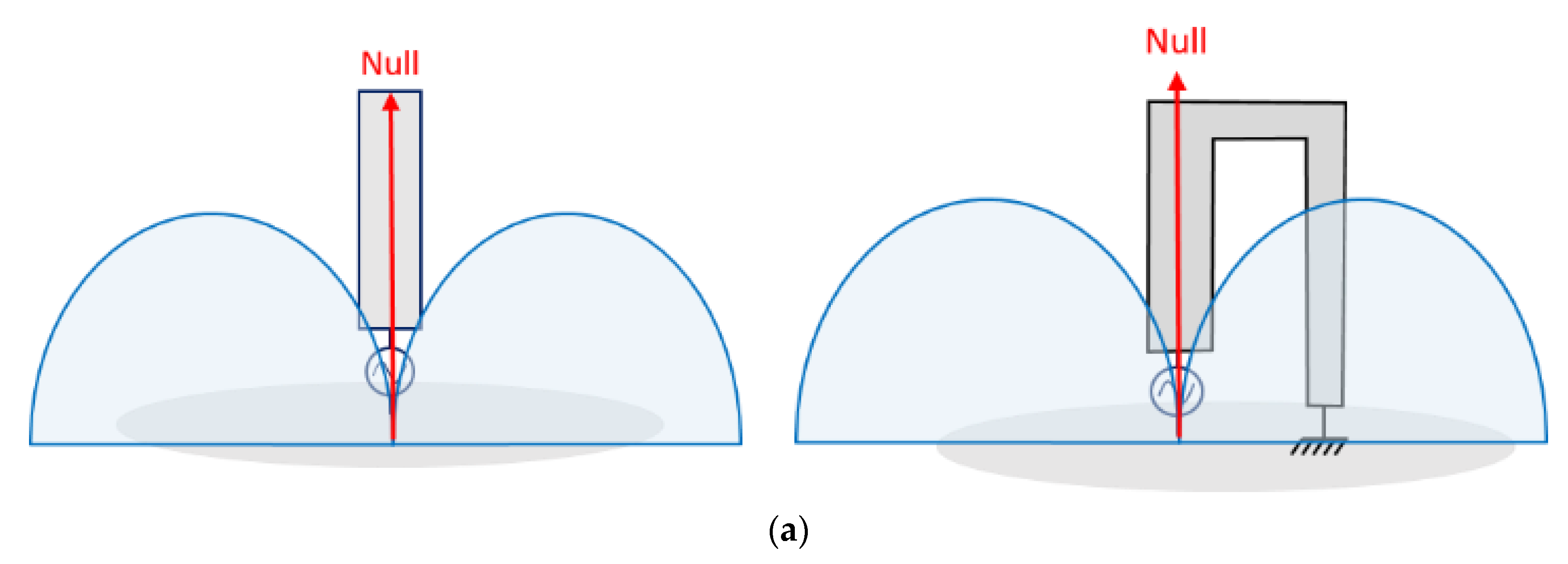

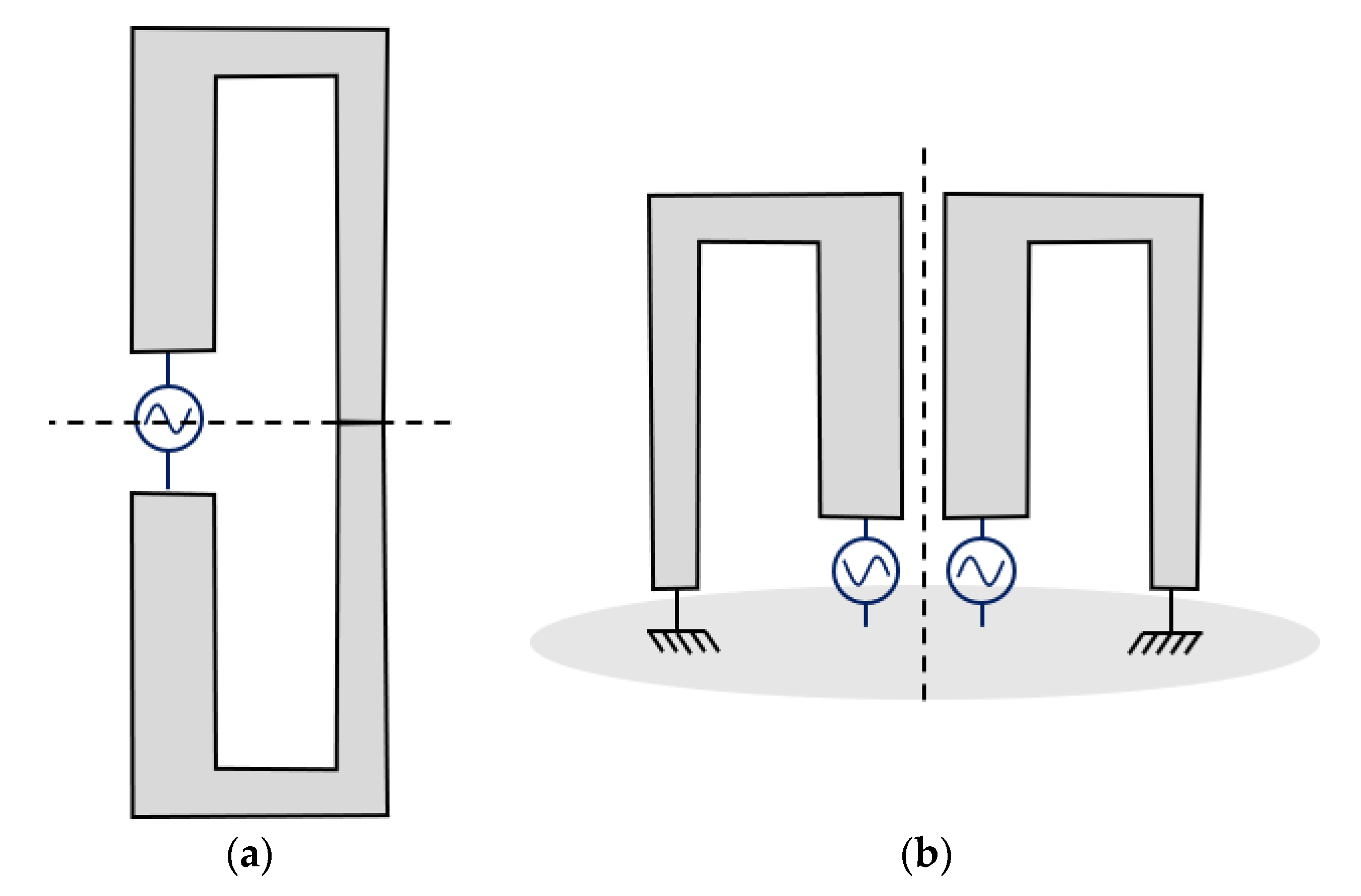
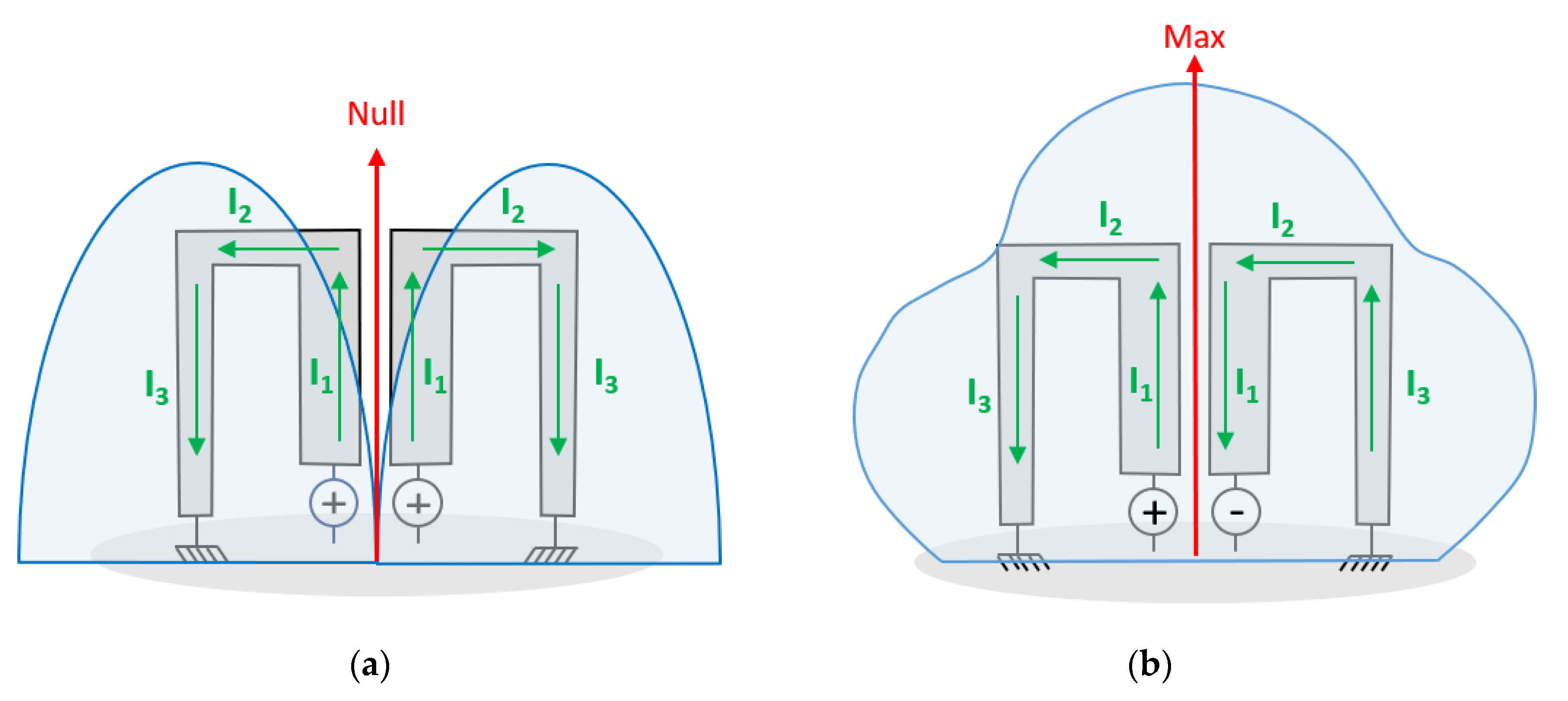

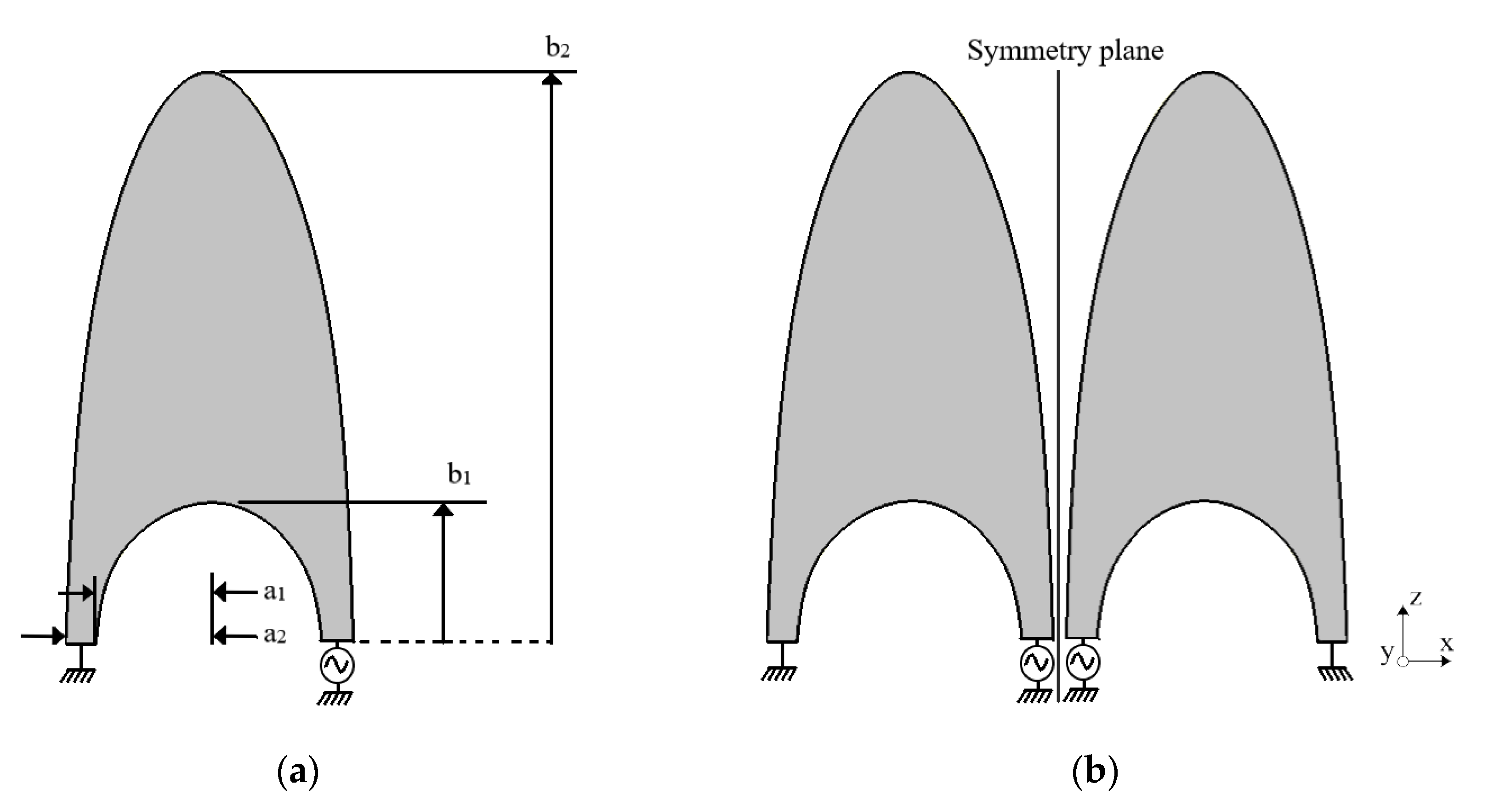

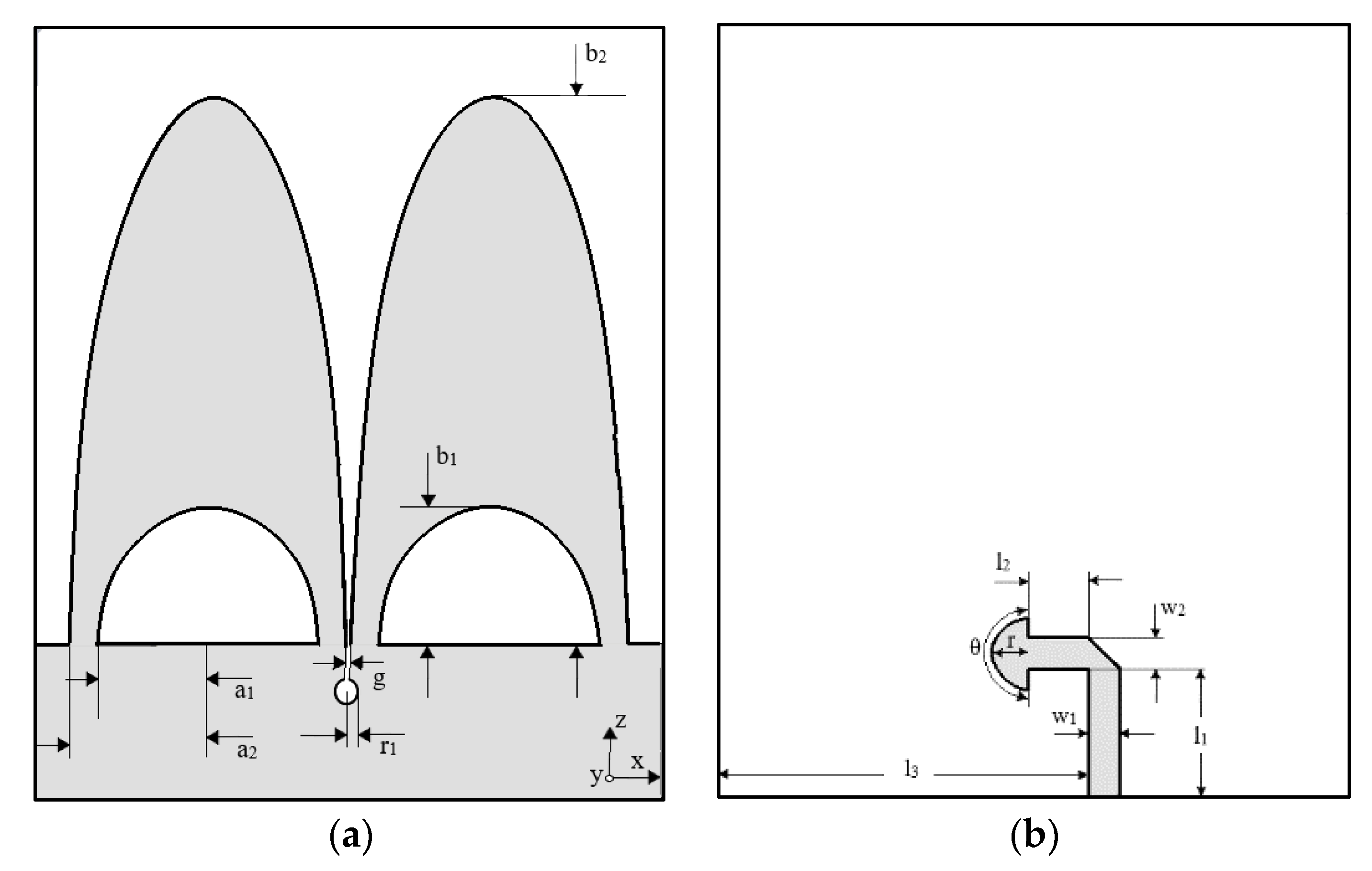
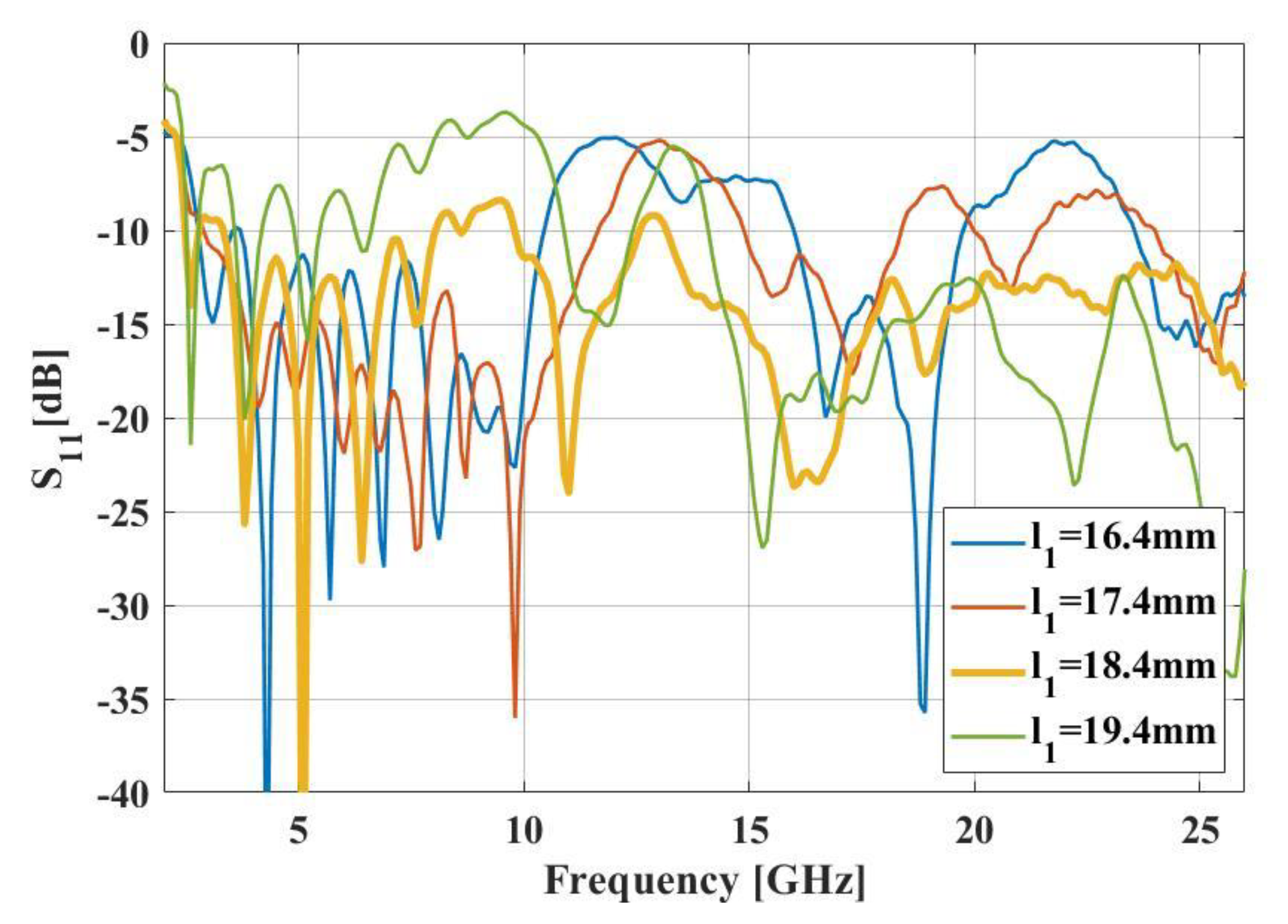
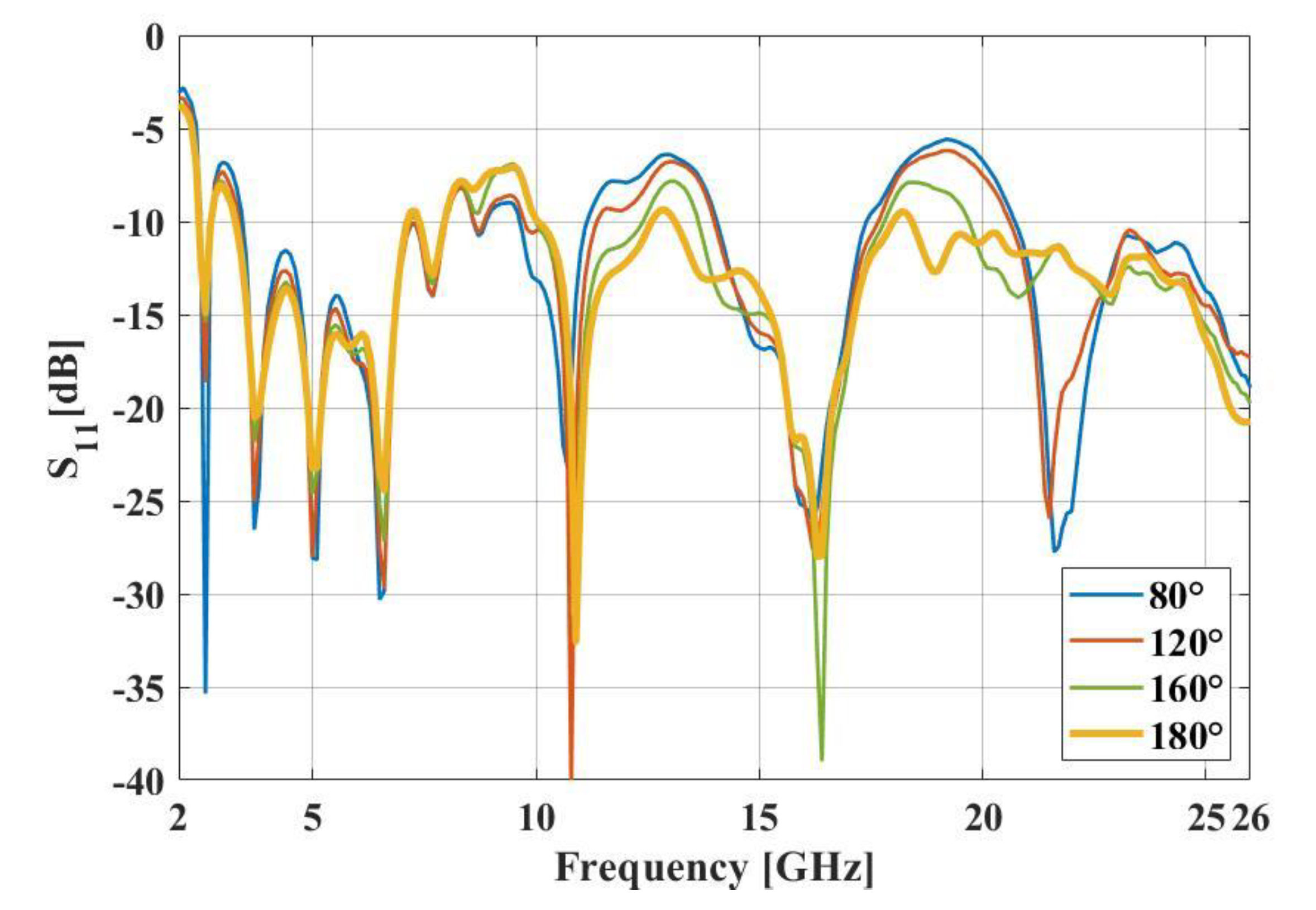

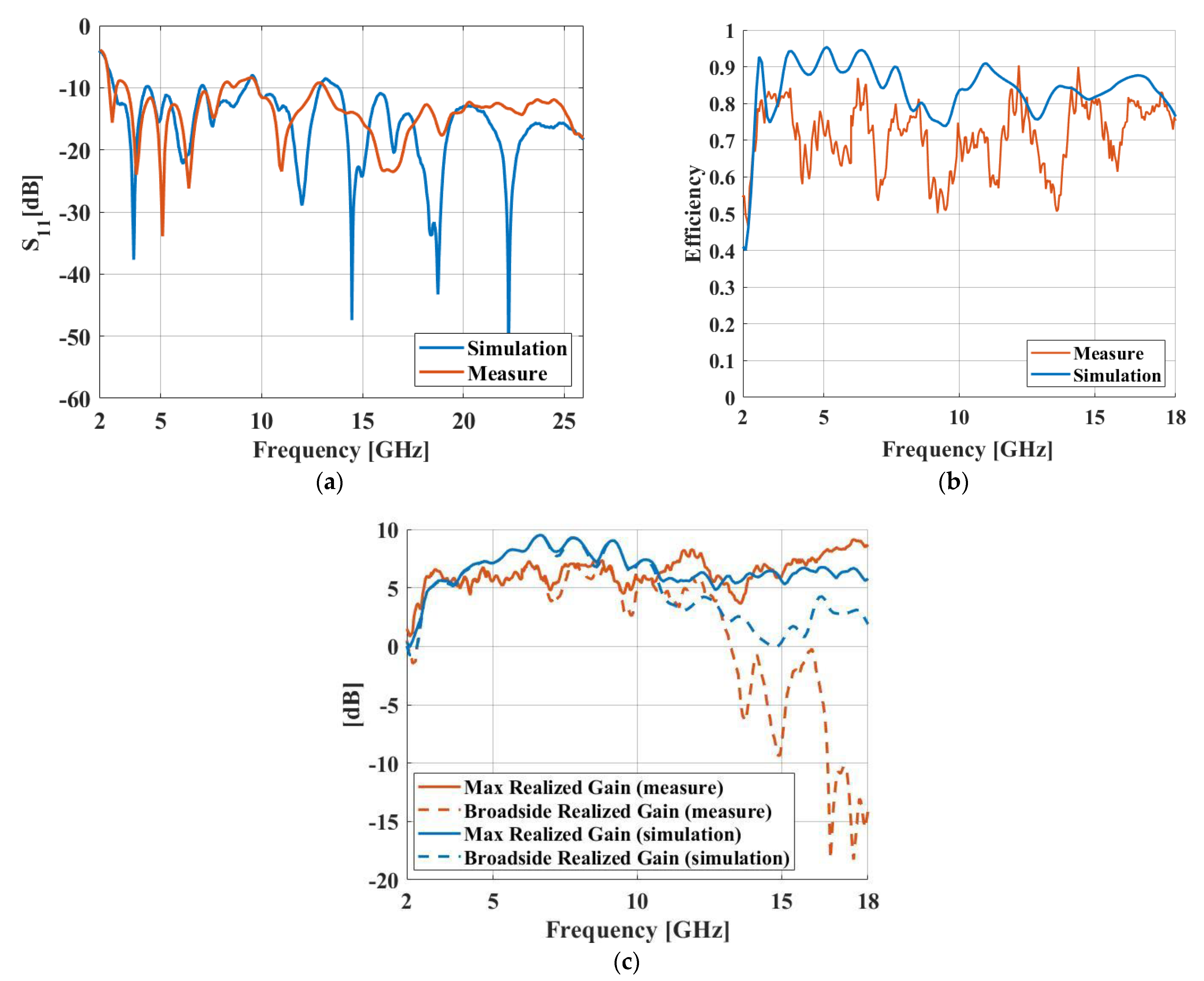
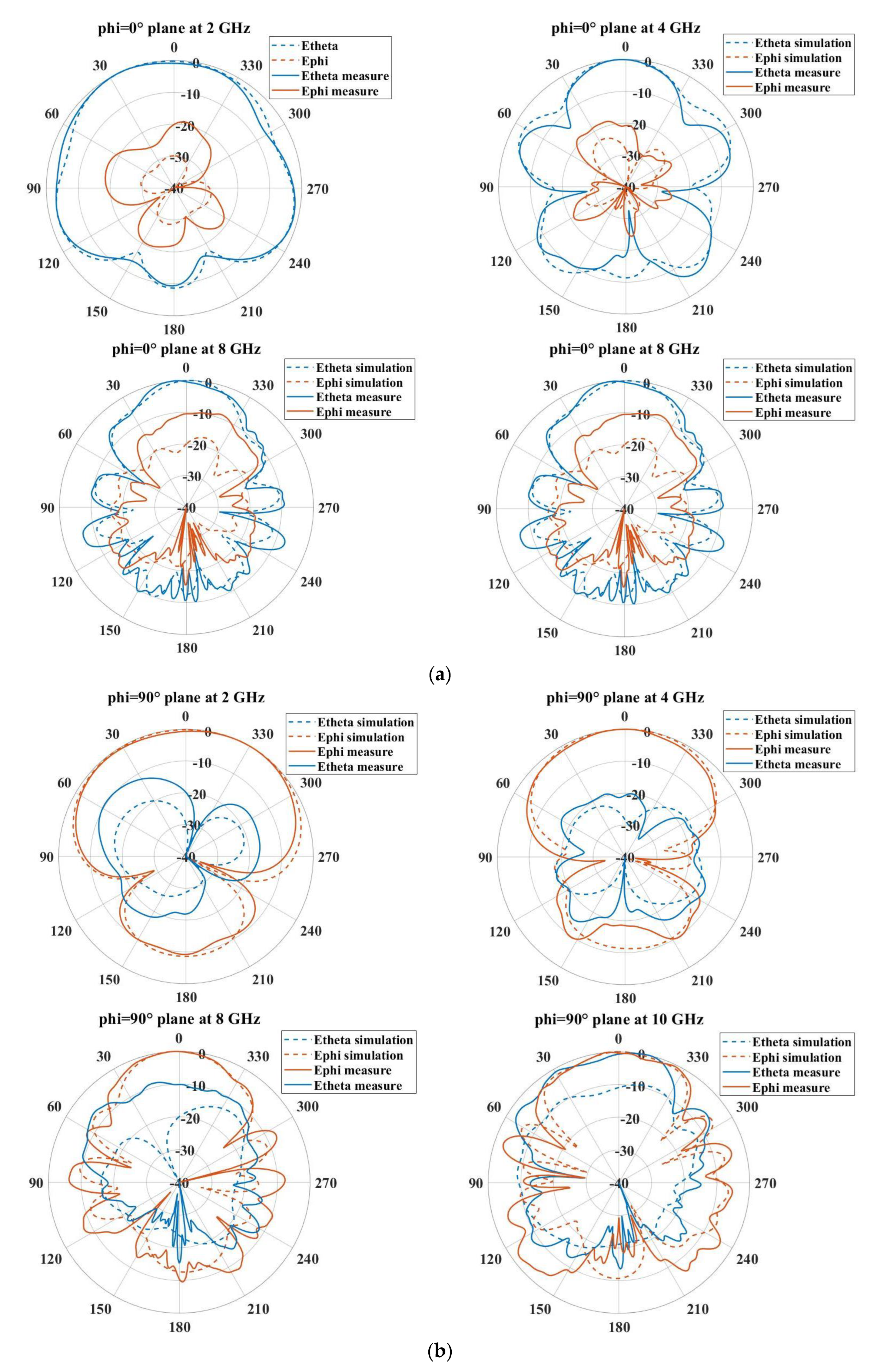
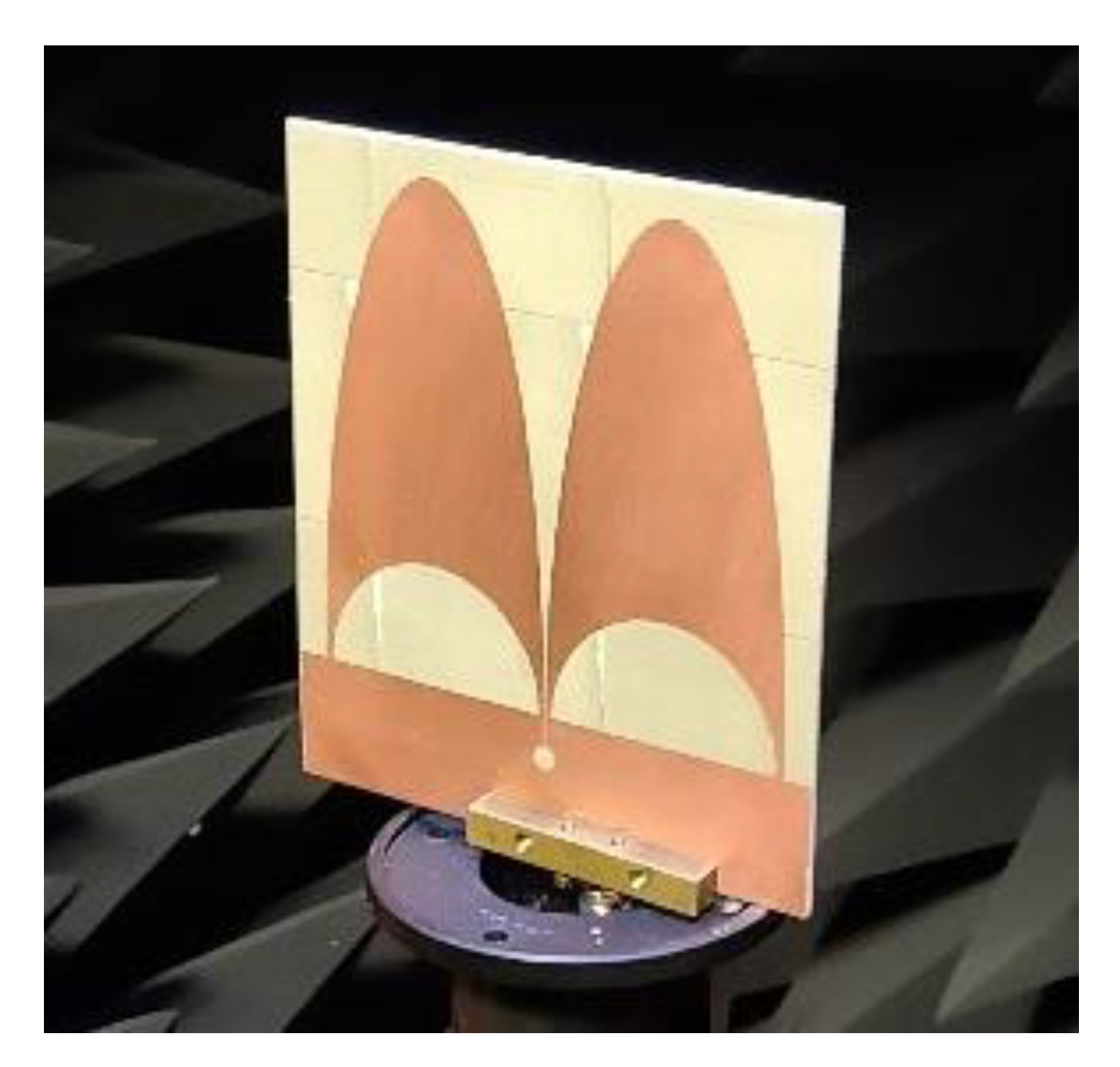
| Parameters | Value (mm) |
|---|---|
| a1 | 16 |
| a2 | 20 |
| b1 | 20 |
| b2 | 80 |
| g | 0.3 |
| r1 | 2 |
| l1 | 18.4 |
| l2 | 8.85 |
| l3 | 53 |
| w1 | 4.1 |
| w2 | 4.2 |
| r | 5.42 |
| θ | 180° |
| Reference | Type | Bandwidth (GHz) | Gain (dBi) | Reconfigurability | |
|---|---|---|---|---|---|
| [9] | Square monopole | 2.38–5.2 | 1.5–4.5 | No | |
| [16] | Folded dipole | 30.3–53.7 | 4.6–6.7 | No | |
| [17] | Modified folded dipole | 26.3–29.75 | 5.51 | No | |
| [21] | Thick Folded dipole | 1.2–4.07 | 8.2–11.5 | No | |
| [22] | Dipole | 26.5–38.2 | 4.5–5.8 | No | |
| [23] | Tapered slot antenna | 6.2–12.3 | 3–6 | No | |
| [24] | Vivaldi antenna | 2.9–14.2 | 5.5–9 | No | |
| This work | S11 < −6 dB | Folded dipole | 2.3–26 | 2.9–8.2 | Yes |
| S11 < −10 dB | 3.3–8, 9.8–12.6 and 13.2–26 | ||||
Disclaimer/Publisher’s Note: The statements, opinions and data contained in all publications are solely those of the individual author(s) and contributor(s) and not of MDPI and/or the editor(s). MDPI and/or the editor(s) disclaim responsibility for any injury to people or property resulting from any ideas, methods, instructions or products referred to in the content. |
© 2023 by the authors. Licensee MDPI, Basel, Switzerland. This article is an open access article distributed under the terms and conditions of the Creative Commons Attribution (CC BY) license (https://creativecommons.org/licenses/by/4.0/).
Share and Cite
Greard, R.; Himdi, M.; Lemur, D.; Le Dem, G.; Thaly, P.; Le Meins, C. A Semi-Elliptical UWB Folded Dipole Antenna. Electronics 2023, 12, 2788. https://doi.org/10.3390/electronics12132788
Greard R, Himdi M, Lemur D, Le Dem G, Thaly P, Le Meins C. A Semi-Elliptical UWB Folded Dipole Antenna. Electronics. 2023; 12(13):2788. https://doi.org/10.3390/electronics12132788
Chicago/Turabian StyleGreard, Romain, Mohamed Himdi, Dominique Lemur, Gwenal Le Dem, Pierre Thaly, and Cyrille Le Meins. 2023. "A Semi-Elliptical UWB Folded Dipole Antenna" Electronics 12, no. 13: 2788. https://doi.org/10.3390/electronics12132788
APA StyleGreard, R., Himdi, M., Lemur, D., Le Dem, G., Thaly, P., & Le Meins, C. (2023). A Semi-Elliptical UWB Folded Dipole Antenna. Electronics, 12(13), 2788. https://doi.org/10.3390/electronics12132788







